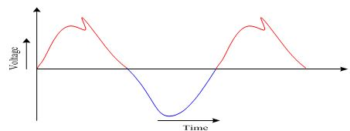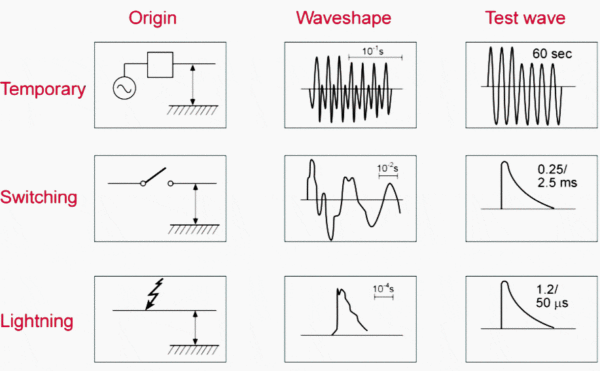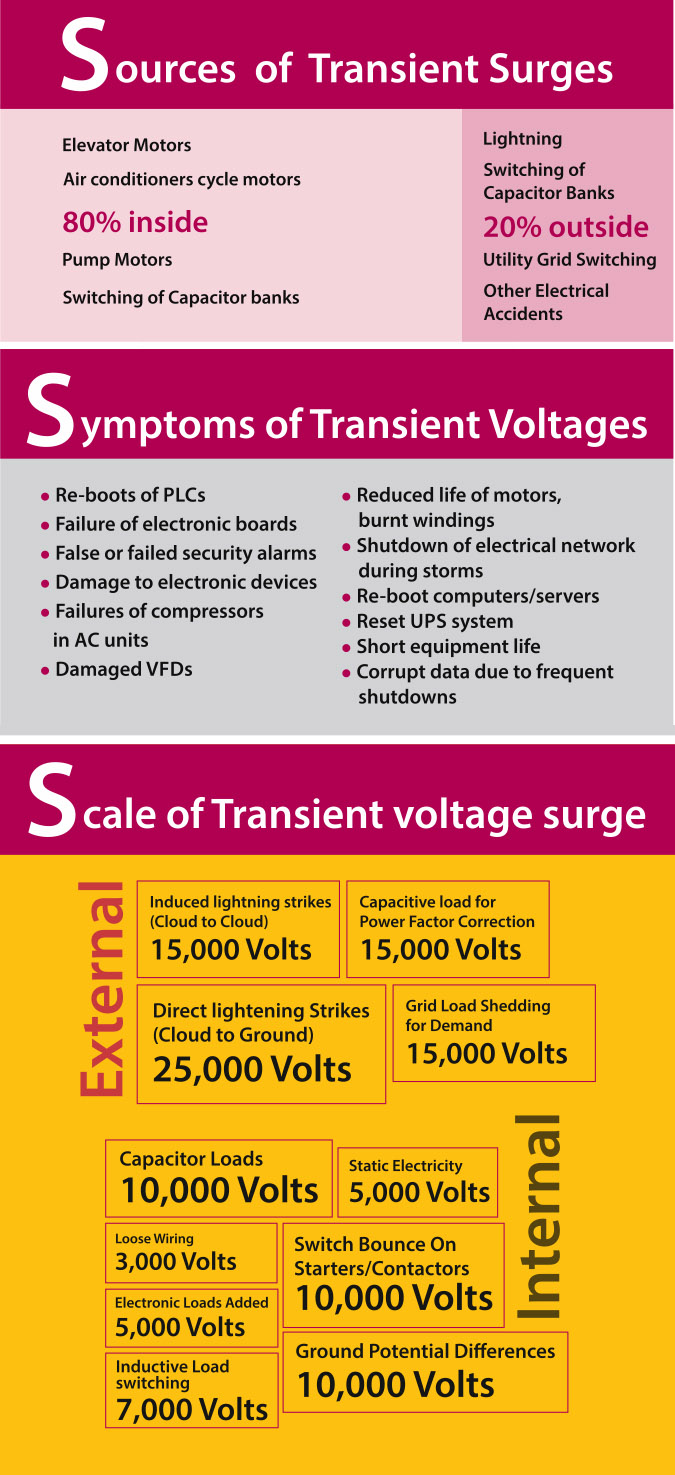Published On: May 10, 2019
The biggest problem with transients in the electrical networks is that very few recognize it as a problem since it exists for such short duration that it disappears even before one grip . Transients over voltage costs companies in many ways including direct damage to the power distribution systems, malfunctioning of sensitive electronic equipment, downtime and much more. The transient voltages can originate from inside the facility or emanate from the grid. With greater use of electronics and non-linear loads in every facility, it is important for facility managers and electrical network heads to go beyond the symptoms and understand the different types of transients and their effects on electrical systems.
INTRODUCTION
Electrical transients are observed at various levels within the electrical and computing systems. But the range of transient over voltages could be really vast – starting from the destructive lightning strike in instance of a thunderstorm, to the almost unnoticed static discharge from a human finger. Most of the transient overvoltage events could be traced to the inside of the facility. While the extreme ends of the over voltage range (lightning etc.) is a rare possibility the fluctuations in utility power are a major source of transients coming from outside of the electrical network.
Transient over voltages build a stress on the electrical network in several ways. It is observed that a few plants experience hundreds of transient events every hour with the voltage impulses exceeding several times the system voltage.
Typically, the end users are exposed to the symptoms and directly go after the solutions such as Surge protective devices (SPDs), to reduce the magnitude and duration of voltage transients.
This article focuses on developing an understanding of transients from various angles for the end users – its root causes, types, symptoms and solutions.
TRANSIENTS VOLTAGE CHARACTERISTICS
Transient voltage is often referred to as the most damaging power disturbance. And rightly so, given the number of direct and indirect ways in which it can cause damage to a healthy electrical network. Broadly, the transients are characterised as either impulsive or oscillatory.
|
Impulsive Transients Observed as a sudden peak in the voltage or current levels in either positive or negative direction, the impulsive transients can be further classified as fast, medium or slow events, depending on the rise time from nominal to peak voltage. Poor grounding is one of the biggest causes of impulsive transients. Other major causes include lightening, switching on of large number of inductive loads such as motors and Electro Static Discharge. |
|
Oscillatory Transients Characterised by a sudden change in voltage which is oscillating at the natural frequency. The oscillating currents have a tendency to decay to zero within the same cycle. Oscillatory Transients are a result of switching-off a capacitive load, typically a capacitor bank. |
TRANSIENT OVER VOLTAGE TYPES
Over voltage is said to have occurred in an electrical network when the voltage rises over 110% of the nominal rated voltage. Over voltages are a result of several factors. The over voltage also results in several adverse effects on the electrical network.
The transient over voltages can be classified as per the frequency content of the waveforms.
Types of over voltages
Transient over voltage events typically last from less than one microsecond and appear equally and in phase from each power conductor to ground
| Type of Over voltage | Root Causes | Characteristics |
|---|---|---|
| Temporary Power frequency over voltage (Low frequency) |
Temporary over voltages caused due to the frequency changes during operation of non-linear loads in the electrical network |
|
| Switching Over voltages (medium frequency) |
A temporary over voltage resulting from switching operations in devices such as capacitors, transformers etc. | Switching of capacitor banks Faults and voltage interruption Energization/DE energization of transformers Other |
| Lightning Over voltages (high frequency) |
A huge temporary surge in voltage due to a lightning stroke terminating at a phase conductor, shield conductor, any other part of a power system, or a nearby object (tree, etc.) | Cloud to ground flash due to lightening in thunderstorm |
As observed in the figure above, the magnitude of frequency of over voltages from devices or equipment from within the facility is relatively low, as compared to the other two types of over voltages. While the magnitude may range up to 50% of the nominal voltage, they are the slow and silent killers. Most modern over voltage protection devices may not be able to arrest these over voltages and lead to a slow damage of the equipment.
KEY SOURCES OF TRANSIENTS
Among all the sources, the majority of transient voltage events in the electrical networks are caused by Switching. The electrical network could experience frequent switching from several sources including T&D lines, cables, transformers, generators, motors, capacitors, breakers etc. All these and other devices generate a ‘switching’ surge in the voltage. However, most prominent among all these is the surge created due to switching of capacitors and energising generators.
Lightening
Lightening is among the most visible external source of transient voltage. The transients are induced by lightening into the conductors, either due to direct lightning strike (rare occurrence), but mostly as a result of lightning strikes near the power line.
Studies suggest that even a cloud-to-cloud discharge can create a significantly higher transient voltage on the transmission lines. It should be noted that this transient is created without the lightning not actually striking or touching the electrical network.
Capacitor Switching
Capacitors are used to provide reactive power to ensure a unity power factor. One of the major drawbacks of capacitors is building up of oscillatory transients as they are switched on. There are two types of Capacitors – fixed and active. The former stays energised all the time while in the latter capacitor banks are switched on depending on the load levels and other parameters. The over voltage events are typically observed when these capacitors are switched on in view of an increase in load, especially during the start of the shift or day.
The transient over voltage events during capacitor switching lead to tripping of Adjustable Speed Drivers (ASDs), and malfunction of loads with electronic controls – automated valves, equipment on PLC or SCADA systems etc. The transient voltage causes a rise in the dc link voltage which leads to tripping of the drive off-line due to the over voltage. Also, these events are mostly sudden and will occur without any impact on the relatively non-sensitive loads such as lighting etc.
Transformer Energising
Inrush currents are commonly observed when Transformer is energised. The inrush currents create harmonics and if the electrical system has a resonance near the harmonic frequencies, dynamic over voltage conditions are created. This often results in failures of arrestors and damage to sensitive electronics in the electrical network. Further, this type of over voltage can significantly alter the life of capacitors in the electrical network.
Cycling motors in ACs, elevators
The cycling motors, typically used in ACs, elevators etc. cause Electrical Fast Transients (EFTs). While these transients have very little energy and are events of very short duration, they can interfere to disturb the operation of electronic loads. The cycling motors in elevators are observed to develop spikes up to 1 kV, while those in arc welding or large motor starters can cause spikes of even higher voltages.
Other key sources of Transient Voltages include:
- Power electronic components
- Electrostatic Discharge (ESD)
- Copier and printer machines
- Welding loads
- Furnace, ovens, induction heaters etc.
- Motor load start-up and turn-off
- Faulty grounding, connections
- Faults in circuit breakers
- Zero Crossing Switch is used to solve issues caused due to transients from Capacitor Switching. Zero crossing refers to the point when the sine wave reaches the zero level, before descending further on the negative cycle. A Zero crossing switch monitors the sine wave and ensures that the capacitor switching occurs closer to the sine wave’s zero crossing time.
Overview of key global standards for Surge Protection
- BS 7671:2018 18th Edition of the IET Wiring Regulations covers protection against voltage and electromagnetic disturbances, including protection against transient overvoltages that arise from lightning or switching
- BS EN 62305-2 – Enlists the requirements for high risk facilities such as nuclear facilities
- BS EN 62305 (18th Edition of the IET Wiring Regulations) lists the standards for facilities with the risk of direct lightning strike to a structure or to the overhead lines connected with the structure
- IEEE C62.41.1, Guides on the Surge Environment in Low-Voltage (1000 V and less) AC Power Circuits
- IEEE C62.41.2, Recommends practices on characterization of Surges in Low-Voltage (1000 V and less) AC Power Circuits”
- IEEE C62.47-1992 IEEE Guide on Electrostatic Discharge (ESD): Characterization of the ESD Environment
- IEEE C62.48, Guide on Interactions Between Power System Disturbances and Surge-Protective Devices
- IEEE C62.72, Guide for the Application of Surge-Protective Devices for Low-Voltage (1000 V or Less) AC Power Circuits
CONCLUSION
The damage from transient over voltage events are not always visible. Overvoltage can cause damage to components connected to the power supply
and lead to insulation failures, permanent damage to sensitive electronic components, over-heating etc. With these, there is a high chance for the diagnosis being misled or marked as completely unknown. Moreover, with no improvement in understanding the characteristics of the transients in the electrical network, the adverse outcomes can be considered as normal by the internal maintenance team.
With growing trend of miniaturisation and IoT, there is going to be more electronics in every device, then ever before. This not only means that transient voltage will be on the rise, but our devices will also be more susceptible to damages from the transients. An increase in transient voltage results in increased power disturbance, interruptions and therefore an adverse impact on productivity and product quality.
But as discussed earlier, to catch the culprits, that is the sources of voltage transients still remains a challenge. As the first step in ensuring healthy electrical network, Facility Managers, equipment designers and utilities must invest time and efforts, consistently, in discovering the voltage transient issues in their networks. Whether its lightning or configuration of equipment that is designed to improve the Power Quality or save money in penalties etc., the first step is to ensure the most appropriate application of protective devices.
REFERENCES
- Sources of Transient Voltages – ECM Web – https://www.ecmweb.com/contractor/looking-sources-transient-overvoltages
- Impulsive Transients – http://www.powerqualityworld.com/2011/05/impulsive-transients-power-system.html
- Transient over voltages – https://www.powerstandards.com/tutorials/transient-overvoltages/











